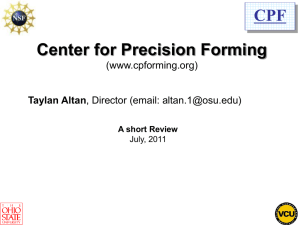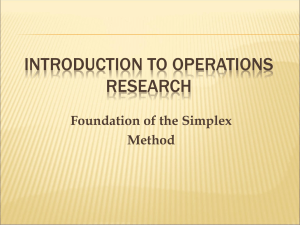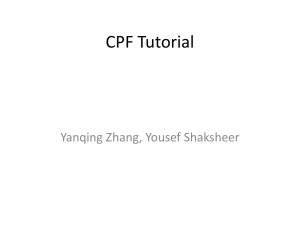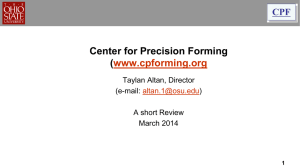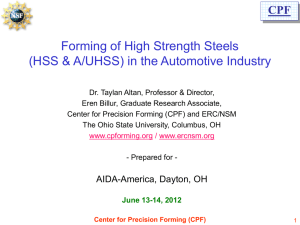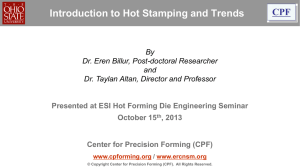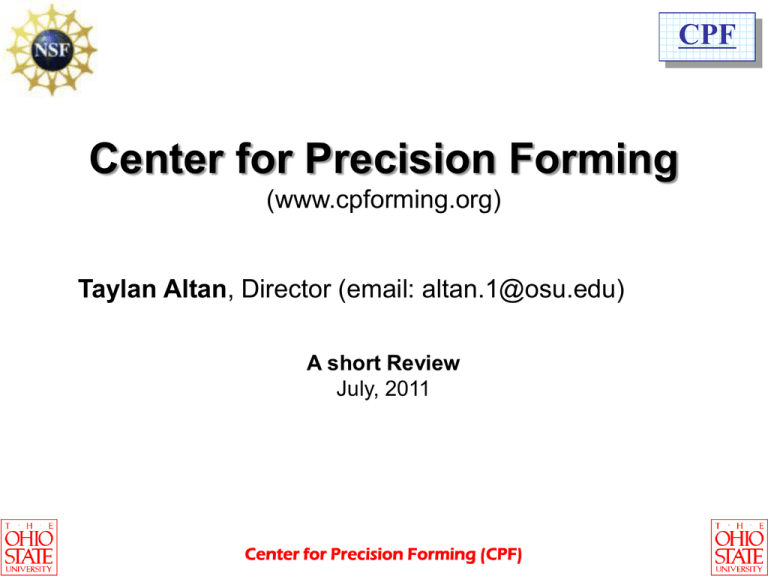
CPF
Center for Precision Forming
(www.cpforming.org)
Taylan Altan, Director (email: altan.1@osu.edu)
A short Review
July, 2011
Center for Precision Forming (CPF)
CPF
Introduction
•The Ohio State University (OSU) and have established the
Industry/University Cooperative Research Center (I/UCRC) on
Precision Forming (CPF) focusing on research needs of metal
forming industry.
• Funding is provided by National Science Foundation (NSF) and
member companies.
• CPF (www.cpforming.org) benefits from research conducted at
Engineering Research Center for Net Shape Manufacturing
(ERC/NSM – www.ercnsm.org).
Center for Precision Forming (CPF)
CPF
Objectives
• Improve existing metal forming processes/products and develop
new innovative processes, tooling and equipment.
• Conduct projects in close collaboration with industry and transfer
the results to the member companies.
• Train and educate engineers in the fundamentals and practice of
metal forming science and technology.
Center for Precision Forming (CPF)
Current Members
•Boeing
•Cincinnati Inc
•Dienamic Tooling Systems
•ESI North America
• EWI
•Honda
•Hyundai
• ESI North America
• Interlaken Technology Corp.
• POSCO (Korea)
• IM Steel
• Scientific Forming Technologies (SFTC) Corp.
• IMRA America
• Metalsa
• Tyco
Center for Precision Forming (CPF)
CPF
R & D at The Center for Precision Forming
CPF
Research and Development in Sheet Metal Forming
Center for Precision Forming (CPF)
(formerly Engineering Research Center for Net Shape Manufacturing)
www.cpforming.org / www.ercnsm.org
The Ohio State University
June 1st 2011, Columbus, Ohio
© Copyright Center for Precision Forming (CPF). All Rights Reserved.
Center for Precision Forming (CPF)
R&D in Sheet Metal Forming at CPF
CPF
CPF 1.1 - Elevated temperature stamping and hydroforming (Mg, Al and
alloys)
CPF 1.4 -
Control of springback and dimensional tolerances in forming
AHSS parts
CPF 2.1 – Determination of room temperature material properties (flow
stress, formability, anisotropy) of sheet materials under biaxial conditions
CPF 2.3 – Investigation tribological (friction/lubrication/wear) conditions in
forming uncoated and galvanized AHSS
CPF 2.5 – Evaluation of lubricants for improving stamping quality
CPF 4.1 – Practical use of multi-point control (MPC) die cushion technology
in production of stamped parts
Center for Precision Forming (CPF)
6
R&D in Sheet Metal Forming at CPF
CPF
CPF 4.2 – Tube hydroforming
CPF 5.1 – Evaluation of bendability of AHSS
CPF 5.2 – Prediction and elimination of edge cracking of AHSS in stretch
flanging
CPF 5.3 – Blanking and shearing of sheet metal
CPF 5.5 – Hot stamping of boron steels
CPF 5.6 – Applications of servo drive presses in stamping
Center for Precision Forming (CPF)
7
CPF
CPF 1.1 - Elevated Temperature
Stamping and Hydroforming (Mg,
Al And Alloys)
Manan Shah
Jose L. Gonzalez-Mendez
Eren Billur
Center for Precision Forming (CPF)
8
Warm Forming of
Al, Mg, Ti & SS (Cup Diameter: 40 mm)
(in cooperation with AIDA)
AA5754-O
T(°C)
RT
250
300
CPF
AZ31B-O
LDR
T(°C) LDR
2.1
RT
2.5
275 2.6
Velocity : 2.5-50mm/sec
2.9
275 3.2
Center for Precision Forming (CPF)
9
Warm Forming of
SS 304 (Cup Diameter: 40 mm)
(in cooperation with AIDA)
Center for Precision Forming (CPF)
CPF
10
Warm Bulge Test
(up to 350C/660F)
Experimental Output
CPF
Comparison
Bulge height, Hexp vs Time
One experimental output is
compared with FE output for
every combination (Kj, nj
and mj)
Pressure, Pexp vs Time
Strain, Sexp vs Time
FE Output
tn
Height (mm)
Bulge
Bulge Height (mm)
40
Bulge height, HFE vs Time
35
Every comparison
results in an error
function (E1, E2,
…, Ej)
30
25
t2
20
15
t1
10
5
0
0
r0
10
r1
20
30
40
60
50
Coordinate (mm)
r3 r4 r5
rRadial
2
Radial Coordinate (mm)
Pressure, PFE vs Time
Strain, SFE vs Time
70
n
m
K
Center for Precision Forming (CPF)
11
Warm Forming
FEA using PAMSTAMP 2G 2009
CPF
(in cooperation with GM and Interlaken)
Punch stroke= 0 mm
Punch stroke= 35 mm
Punch
Blank
Holder
Sheet
Fluid
pressure
Punch
Die
Blank
Holder
Die
Reverse
Punch
Center for Precision Forming (CPF)
12
Warm Forming
FEA and Experiments
CPF
Thickness profile along the curvilinear length for sample 30 (BHF=2.19 kip, Pot
Pressure limit=2000 psi, Punch Stroke =1.00 in)
1.08
1.06
Maximum Thinning
location
1
3
7
1.02
2
1
3
4
5
2
4 5 6
6
0.98
7
8
8
0.96
0.94
0.92
0.9
Part Profile Comparison-CMM and FE
0
50
100
150
200
250
0.2
Curvilinear Length (mm)
Experimental measurements with Error bar
0
FE thickness profile
0
1
2
3
4
5
6
7
8
-0.2
Part Depth (in)
Thickness (mm)
1.04
1
-0.4
-0.6
-0.8
-1
-1.2
-1.4
Center for Precision Forming (CPF)
Radial Distance (in)
CMM Data for Punch Stroke= 1.35 in (34.3 mm)
13
FE profile for Punch stroke= 1.35 in (34.3 mm)
CPF
CPF 1.4 - Control of Springback
and Dimensional Tolerances in
Forming AHSS Parts
Nimet Kardes-Sever
Yurdaer Demiralp
Dr. Changhyok Choi
Center for Precision Forming (CPF)
14
Springback
Load-Unload Tensile Test
(in cooperation with EWI)
Center for Precision Forming (CPF)
CPF
15
Springback in S-Die Test (FEA and Experiments)
CPF
(in cooperation with EWI and IVF)
Material: DP 780, DP 600
thickness: 1 mm, 0.75 mm
U-flanging without
stretching
U-bending without
stretching
U-flanging with
stretching
U-bending with
stretching
S-shape forming with – without stretching
Center for Precision Forming (CPF)
16
Springback in S-Die Test (FEA and Experiments)
CPF
(in cooperation with EWI and IVF)
U-flanging test
U-bending test
Schematic of S-shape punch
U-flanging sample on S-shape punch
U-bending sample on S-shape punch
S-shape bending sample on S-shape punch
Center for Precision Forming (CPF)
17
CMM measurements of S-Die Test Samples
CPF
Calculation of springback for S-Die Test samples:
• Bending angle under load was measured by camera when possible. When the tool is closed it is
not possible to take pictures. Therefore, it was assumed that the specimen geometry under load is
determined by tool geometry.
• Bending angle after unloading was measured by protractor and camera when possible and
Coordinate Measurement Machine (CMM).
• For complex samples, sections before and after springback were compared.
Schematic of CMM measurements on a sample
Center for Precision Forming (CPF)
18
CPF
CPF 2.1 - Determination of
Room Temperature Material
Properties of Sheet Materials
Under Biaxial Conditions
Eren Billur
Yurdaer Demiralp
Nimet Kardes-Sever
Ji You Yoon
Center for Precision Forming (CPF)
19
Sheet Material Properties
Viscous Pressure Bulge (VPB) Test
(in cooperation with many companies)
CPF
Laser
Test Sample
Viscous
Medium
Downward
motion
clamps the
sheet
Continued
downward
motion
forms the
bulged
sheet
Pressure
Transducer
Stationary
Punch
Before Forming
After Forming
Center for Precision Forming (CPF)
20
Sheet Material Properties
Tensile Test vs. VPB Test
CPF
Due to necking, flow stress data from tensile test is limited to low strains.
Bulge test is useful to determine flow stress curve for metal forming
applications and FE simulations.
Bulge test is useful to determine the quality (formability) of sheet materials.
_
Effective Stress ( ) [MPa]
1000
0.49
800
0.15
600
400
DP600 - t 0 = 1mm
200
Bulge Test
Tensile Test
0
0
0.1
0.2
0.3
_
Effective Strain ( )
0.4
Center for Precision Forming (CPF)
0.5
21
Determination of Sheet Formability
Using VPB Test
CPF
Graph shows dome height comparison for SS 304 sheet material from eight
different batches/coils [10 samples per batch].
Highest formability G , Most consistent F
Lower formability and inconsistent H
Center for Precision Forming (CPF)
22
Materials Tested with VPB Test at CPF
(data available to CPF members)
St 14
St 1403
AISI
1018
AKDQ
1050
DR 120
DDS
BH 210
HSS
DP500
DP 590
DP 600
DP 780
TRIP 780
DP 980
Steels
DP 780-CR
DP 780-HY
Bare DP 980 Y-type X
Bare DP 780 T-Si type
GA DP 780 T- AI Type
GA DP 780 Y-type U
GA DP 780 Y-type V
DQS-270F GA-Phosphate
coated
DQS-270D GA-Phosphate
coated
CPF
Aluminum and Magnesium Alloys
AA 6111
AA 5754-O
X626 -T4P
AZ31B
AZ31B-O
Stainless Steels
SS 201
SS 301
SS 304
SS 409
SS 410 (AMS 5504)
SS 444
LDX 2101
Center for Precision Forming (CPF)
23
CPF
CPF 2.3 - Investigation Tribological
(Friction/Lubrication/Wear)
Conditions in Forming Uncoated and
Galvanized AHSS
Eren Billur
Ryan Patton
Center for Precision Forming (CPF)
24
Evaluation of Die Materials/Coatings
for Galling and Die Wear Using The
Strip Drawing and Ironing Test (SDT/SIT)
(in cooperation with HONDA )
CPF
Strip Drawing Test
Galling observed on a die insert
Strip Ironing Test
Higher contact pressure accelerates the tool wear and galling, in stamping
AHSS.
Various die materials and coatings are evaluated by SDT and SIT.
Center for Precision Forming (CPF)
25
CPF
CPF 2.5 - Evaluation of Lubricants
for Improving Stamping Quality
Soumya Subramonian
Nimet Kardes-Sever
Yurdaer Demiralp
Center for Precision Forming (CPF)
26
Evaluation of Lubricants Using The
Cup Drawing Test (CDT)
CPF
(in cooperation with HONDA and several lubricant companies)
Performance evaluation criteria (cups drawn to same depth):
i.
Higher the Blank Holder Force (BHF) that can be applied without fracture in the
drawn cup, better the lubrication condition
ii. Smaller the flange perimeter, better the lubrication condition (lower coefficient of
friction)
Center for Precision Forming (CPF)
27
Evaluation of Lubricants Using The
Cup Drawing Test (CDT) – Results
CPF
(in cooperation with HONDA and several lubricant companies)
Flange Perimeter and Punch Force for 24 ton BHF (270D/GA)
160
Flange Perimeter (mm)
780
150
775
770
140
765
130
760
755
120
750
110
745
740
Maximum Punch Force (kN)
785
100
M+L21
M+L6
M + L15 M + L19
Mill oil+ Lubricant
Flange Perimeter (mm)
M+L23
M+L22
Maximum Punch Force (kN)
Center for Precision Forming (CPF)
28
CPF
CPF 4.1 - Practical Use of Multipoint Control (MPC) Die Cushion
Technology in Production of
Stamped Parts
Dr. Taylan Altan
Center for Precision Forming (CPF)
29
Case studies in process simulation
CPF
Multi-point Control systems (MPC)
Hydraulic systems
IFU flexible Blank holder / Binder
hydraulic control unit
Erie binder unit (hydraulic system)
with liftgate tooling inside press
(Source: USCAR)
Center for Precision Forming (CPF)
(Source: IFU, Stuttgart)
30
Case studies in process simulation
CPF
Multi-point Control systems (MPC)
Application of MPC die cushion technology in stamping
Sample cushion pin configuration (hydraulic MPC unit) for drawing stainless steel
double sink.
(Source: Dieffenbacher, Germany)
MPC is routinely used in deep drawing of stainless steel sinks
Center for Precision Forming (CPF)
31
Case studies in process simulation
CPF
Multi-point Control systems (MPC)
Previous work at CPF in
Blank Holder/Binder Force (BHF) determination
•
CPF in cooperation with USCAR consortium developed software to program MPC
die cushion system in stamping.
Methodology for BHF determination
(Numerical optimization techniques coupled with FEA)
Inputs required
• Quality control parameters
(wrinkling, thinning)
• No. of cushion cylinders (n)
• Tool geometry (CAD)
• Material properties
• Process conditions
Software developed at
CPF for BHF
determination
BHF at each
cushion pin as
function of punch
stroke
FEA Software
(PAM-STAMP, LS-DYNA)
Center for Precision Forming (CPF)
32
Case studies in process simulation
CPF
Multi-point Control systems (MPC)
Use of Multi-point Control (MPC) die-cushion systems helps to control metal flow.
Each cushion pin is individually controlled by a cylinder (hydraulic/ nitrogen gas
/servo control).
Location of
cushion pins/
cylinders in the
die
MPC can be used to accommodate variations in sheet properties & assist in
forming AHSS.
Center for Precision Forming (CPF)
33
Case studies in process simulation
CPF
Multi-point Control systems (MPC)
Die
FE model
Estimation of BHF varying in each cushion
pin & constant in stroke, using FE simulation
coupled with numerical optimization,
developed at CPF (OSU).
Sheet
Geometry : Lift gate inner
Material : Aluminum alloy, AA6111-T4
Initial sheet thickness : 1 mm
Beads
Segmented blank holder
Inner
Binder
Cushion Pin
Punch
[Source: USCAR/OSU]
Outer
Binder
Center for Precision Forming (CPF)
34
Case studies in process simulation
CPF
Multi-point Control systems (MPC)
BHF predicted by FE simulation in individual
cushion pins for forming Aluminum alloy
(A6111-T4, sheet thickness = 1 mm)
11
B la n k h o ld e r fo rc e (k N )
120
10
9 8
13
7
100
15
80
6
60
14
40
Pin 1
20
12
2
3
5
4
0
1
2
3
4
5
6
7
8
9 10
P in n u m b e rs
11
12
13
14
15
Pin locations and
numbering
Center for Precision Forming (CPF)
35
Case studies in process simulation
CPF
Multi-point Control systems (MPC)
Experimental validation of BHF prediction by FE simulation
Bake Hardened steel
(BH210, t = 0.8 mm)
No wrinkles, no tears
Aluminum alloy
(A6111 – T4, t = 1 mm)
Minor wrinkles, no tears
Dual Phase steel
(DP600, t = 0.8 mm)
No wrinkles, no tears
Using a hydraulic MPC system installed in mechanical press, the auto-panel was
formed successfully - with three different materials/sheet thicknesses in the same die by only modifying BHF in individual cushion pins.
Center for Precision Forming (CPF)
36
CPF
CPF 4.2 - Tube Hydroforming
Dr. Taylan Altan
Center for Precision Forming (CPF)
37
CPF
CPF 5.1 - Evaluation of Bendability
of AHSS
Xi Yang
Nimet Kardes-Sever
Yurdaer Demiralp
Dr. Changhyok Choi
Center for Precision Forming (CPF)
38
Prediction of Springback
in V-Die Bending
CPF
(in cooperation with Cincinnati Inc.)
a) Before unloading
b) After unloading
Calculation of springback for V-die bending samples:
• Bending angle under load was measured by camera.
• Bending angle after unloading was measured by protractor and camera.
Center for Precision Forming (CPF)
39
Prediction of Springback
with FEA and BEND in V-Die Bending
CPF
(in cooperation with Cincinnati Inc.)
FEA
BEND
Punch
Sheet
V-die
Schematic of FE model in DEFORM 2D
Screenshot from BEND
Center for Precision Forming (CPF)
40
Prediction of Springback
With BEND in V-Die Bending
CPF
(in cooperation with Cincinnati Inc.)
The program BEND was developed based on the analytical model to predict the
springback in air-bending. (Channel Die or V-Die)
Parameters input to the program
1. Material’s properties
• Strain hardening exponent (n )
• Strength coefficient (K )
• Initial yield stress (YS )
• Young’s modulus (E )
• Poisson’s ratio
• Initial thickness (t0)
• Sheet width (w0)
• Friction coefficient (m)
2. Tool Dimensions
• Punch radius
• Die radius
• Die opening
Center for Precision Forming (CPF)
41
Stretch Bending Test
to Evaluate Formability/Fracture
CPF
Punch diameter: 152.4 mm
Die Ring
Die Ring
RDR
RDR
Sample
Sample
Lock Bead
Rd
Rd
RP
Round Sample
Round
Sample
Round
and Strip
Sample
Blank Holder
Blank Holder
Punch
Punch
before forming
RP
CL
CL
Lock Bead
Lock Bead
after forming
By changing Rd and Rp, we can obtain different stress/strain conditions at fracture.
Center for Precision Forming (CPF)
42
CPF
CPF 5.2 - Prediction and
Elimination of Edge Cracking of
AHSS in Stretch Flanging
Soumya Subramonian
Center for Precision Forming (CPF)
43
Blanking and Flanging
(in cooperation with US Steel and TUM)
CPF
Factors Influencing Hole Expansion
•Edge quality of the hole
•The method used to finish the hole (e.g.
blanking, reaming, etc.)
•Punch/die clearance used in blanking
•Positioning of burr with respect to punch
•Sheet material
Hole Expansion Test
• To investigate the stretch-ability of the finished edges.
• A conical punch, flat bottom punch or spherical punch can be used.
Center for Precision Forming (CPF)
44
CPF
CPF 5.3 - Blanking and Shearing
of Sheet Metal
Soumya Subramonian
Tingting Mao
Center for Precision Forming (CPF)
45
Schematics of Blanking and Shearing
(FEA and Experiments)
CPF
(in cooperation with Tyco and Cincinnati Inc.)
Blanking
Shearing
[www.custompartnet.com/wu/sheet-metal-shearing ]
Center for Precision Forming (CPF)
46
Blanking and Shearing (FEA and Experiments)
Different Zones of Blanked Edge
CPF
Zr
Zr
Zs
Zs
Zf
Zf
(b)
Zb
(a)
Zr: rollover zone
Zs: shear zone
Zf: fracture/rupture zone
Zb: burr
Different zones of the blanked edge (a) simulations and (b) experiments
Center for Precision Forming (CPF)
47
Blanking and Shearing
Critical Parameters
CPF
Effects of the following parameters on the blanked edge quality and
punch load/life are studied:
120
•Punch-die clearance
100
•Punch/die corner radii
•Stripper pressure and design
•Punch end geometry
•Coefficient of friction
60
Snap-thru forces
40
20
0
0
5
10
15
20
-20
•Punch misalignment
-40
•Snap-thru forces / reverse loading
•Vibration and dynamics
Load (% max load)
80
time
Analysis of snap-thru forces during
blanking through simulations
Center for Precision Forming (CPF)
48
CPF
CPF 5.5 - Hot Stamping of Boron
Steels
Eren Billur
Center for Precision Forming (CPF)
49
CPF
Introduction/Hot stamping
- Developed for automotive applications in the 80’s
- Fast growing and an evolving technology for manufacturing crash resistant,
light weight parts with reduced springback
Parts manufactured using hot stamping
Center for Precision Forming (CPF)
50
CPF
Introduction/Technology Overview
- Manganese Boron steel (22MnB5) has ferritic pearlitic microstructure in
as received condition.
- These blanks are heated to austenitisation temperature(~950°C) for 5
minutes.
- The heated blanks are formed and quenched in the press at a cooling
rate higher than 27K/sec.
- Quenching changes the microstructure from austenite to martensite
and the final part is hardened and has an ultimate tensile strength of
around 1500 MPa.
Center for Precision Forming (CPF)
51
CPF
Introduction/Direct Hot Stamping
Direct hot stamping process
Center for Precision Forming (CPF)
52
CPF
Partners/Supporters
National Science Foundation (NSF)
- Supporting CPF/finite element simulations of hot stamping.
IMRA , Japan
- Data base of references and information in hot stamping.
POSCO, South Korea
Tooling System Group, USA
COSKUNOZ (die maker), Turkey
- Providing geometry and experimental data on example hot stamped
components (details are proprietary).
Center for Precision Forming (CPF)
53
CPF
International Co-operation
CPF maintains good relationship with several leading research institutes active
in Hot Stamping technology
Lulea University of Technology, Sweden (Prof. Akerstrom)
University of Erlangen-Nuremberg, Germany (Prof. Merklein)
Leibniz University, Hannover (Prof. Behrens)
University of Padova, Italy (Prof. Bariani)
Tech.Univ.Graz,Austria (Prof. Kolleck)
Toyohashi University of Technology, Japan (Prof. Mori)
Technical University of Munich, Germany (Prof. Hoffman)
Dortmund University of Technology, Germany (Prof. Tekkaya)
Center for Precision Forming (CPF)
54
CPF
FE Simulation of Hot Stamping
Status / Update
Various companies/research groups are using combination of different
FE codes like LS-Dyna, ABAQUS, PAMSTAMP, FORGE, MSC. Marc,
AUTOFORM for simulating the entire hot stamping process
Our Strategy
• Use PAMSTAMP and DEFORM 3D to predict
-Temperature distribution
-Thickness distribution
-Metal flow
-Elastic tool deflection
-Cooling channel optimization
• Simulate and compare results with example parts a) from literature b)
provided by our partner companies
Center for Precision Forming (CPF)
55
CPF
Case Study-1/ AUDI B-Pillar Section
-Bench Mark problem-3 given in
Numisheet-2008.
-2D section of the part is simulated.
-The objective is to predict in the
formed
part:
(a)
thickness
distribution, (b) hardness distribution,
(c) potential defects.
Tooling for hot stamping of B-Pillar
Center for Precision Forming (CPF)
56
CPF
Case Study-1/ AUDI B-Pillar Section
Input geometries for simulation
Die
Punch
Assembly
Blank
Blank holder
Reference: Benchmark problem-3, Numisheet 2008
Center for Precision Forming (CPF)
57
CPF
Case Study-1/ AUDI B-Pillar Section
Top die
(75 C)
22 MnB5
Blank (810 C)
Blank
holder(75 C)
Initial simulation setup
Punch (75 C)
Final simulation setup
-A critical section of the B-Pillar is chosen for 2-dimensional simulation
(DEFORM 2D /Variable mesh density)
Center for Precision Forming (CPF)
58
CPF
Case study-2/ Cooling Channel Design
-For this case study, the geometry used
in the case study-2 was chosen.
-Heat
transfer
module
available
in
DEFORM is used for simulation
-Different combination of cooling channel
configurations and examples from the
literature
are
simulated
uniform
cooling
and
to
achieve
martensite
Temperature distribution at the
end of press stroke
microstructure
Center for Precision Forming (CPF)
59
CPF
Future plans
---Develop a simplified and practical procedure to simulate the entire hot
stamping process with reasonable accuracy using commercial codes
PAMSTAMP, LS-Dyna and DEFORM (predict thinning, defects, hardness)
---Develop a simulation procedure to predict tool and part dimensions during
hot pressing and correct the tool surface profile to obtain accurate part
dimensions and desired hardness distribution (uniform or variable)
---Estimate residual stresses in the part after hot stamping, quenching and
cooling
Center for Precision Forming (CPF)
60
CPF
CPF 5.6 - Applications of Servo
Drive Presses in Stamping
Adam Groseclose
Center for Precision Forming (CPF)
61
Servo-Drive Characteristics
1/2
CPF
• Precise ram position and velocity control, anywhere in
stroke
• Adjustable stroke length (TDC and BDC)
• Ram position/ velocity can be synchronized with
automatic part transfer
• In deep drawing, cycle times can be shorter than in
mechanical presses
• Considerable savings in energy
• Dwell at BDC/ restriking/ vibrating and variable blank
holder force (BHF)
• Max. motor torque available during the entire stroke
Center for Precision Forming (CPF)
62
Servo-Drive Characteristics
2/2
C ra n k o r L in k p re s s
(2
(2)) B
Best
est sp
speed
eed
fo
forr m
maater
teria
ials
ls
C yc le tim e o f m e c h a n ic a l p re s s
F re e m o tio n p re s s
C y cle tim e o f
F ree m o tio n p ress
(6
(6)) SSyynnch
chro
ronnize
ize w
with
ith
feed
feeder
er
Form ing length
(1
(1)) V
Vaaria
riabble
le
stro
k
e
stro k e
len
lenggth
th
M inim u m stroke length
S lid e P o s itio n
F ix e d M o tio n
CPF
T im e
S tan d still at B D C
(3
(3)) Im
Imppro
rovvee
aaccu
ccura
racy
cy bbyy
ddw
wellin
ellingg aatt B
BD
DC
C
(5
(5)) PPrrev
even
entio
tionn ooff
nnooise
ise aanndd sh
shoocckk
aatt co
connta
tact
ct oorr
bbrrea
eakkaaw
waayy ooff
to
toools
ls
(4
(4)) O
Oth
ther
er PPro
roccess
ess
aatt B
BD
DC
C
(M
(M uulti
lti PPro
roccess)
ess)
The flexibility of slide motion in servo drive (or free motion) presses. [Miyoshi, 2004]
Center for Precision Forming (CPF)
63
Servo-Drive Mechanisms
CPF
• Low Torque/ High RPM Motors Use Ball
Screws or/and Linkage Mechanisms
• High Torque/ Low RPM Motors Use
Existing Crank and/or Link Press Drives
Center for Precision Forming (CPF)
64
CPF
Low RPM/High Torque Motor
Drive
Power Source
Balancer tank
Main gear
Capacitor
Servomotor
Drive Shaft
a) C-Frame Servo Press (Aida)
b) Stroke-Time program for warm forming
of Al and Mg sheet
Center for Precision Forming (CPF)
65
Modern Stamping Lines Using
Large Servo-Drive Presses
CPF
• BMW- Leipzig and Regensburg (Germany)/ 2500 ton
servo-drive drawing press (Schuler)/ 17 SPM (2009)
• HONDA- Suzuka (Japan)/ 2500 ton servo-drive drawing
press (Aida)/ 18 SPM (2009)
• New large press lines are planned
– BMW-Schuler- 2011
– HONDA-Aida- 2011
Center for Precision Forming (CPF)
66
Schematic of Servo-press line (Aida/Honda) CPF
2500 ton/ 18 SPM draw press (2009)
Improved
Formability
Improved
Productivity
Energy-Saving
Loading ・ Die cushions have an
・ System with optimized press ・ Press-to-Press
forming requirements for each Motion: System is optimized
energy
regeneration
for each product.
product
system
Center for Precision Forming (CPF)
67
Suzuka Plant Production Picture
(Honda/Aida)
Center for Precision Forming (CPF)
CPF
68
Applications- Deep Drawing 1/3
CPF
Comparison between the slide motions of an 1100 mechanical and servo
drive press for identical slide velocity during forming [Bloom, 2008].
Center for Precision Forming (CPF)
69
Applications- Deep Drawing 2/3
CPF
Decrease in cycle time by reducing the stroke length and operating the servo press in
“pendular” mode (progressive die stamping, 200% increase in output) [Bloom, 2008]
Center for Precision Forming (CPF)
70
Applications- Deep Drawing 3/3
CPF
Decrease in cycle time as well as in impact speed using a servo press
(150% increase in output) [Bloom, 2008]
Center for Precision Forming (CPF)
71
Side Panel Outer Deep Drawing
Case Example (Honda/Aida)
Center for Precision Forming (CPF)
CPF
72
High-speed/ High Accuracy
Servo-Press (Honda/Aida)
Center for Precision Forming (CPF)
CPF
73
CPF
Die Cushion
Force (kN)
Servo-Hydraulic Cushion 1/2
(Courtesy-Aida)
Elimination of Pressure Surge in the Die Cushion
Center for Precision Forming (CPF)
74
Servo-Hydraulic Cushion 2/2
(Courtesy-Aida)
CPF
Power Regeneration: Approx. 70%
Power
Direction
Motor Torque
Direction
Pump
Rotation
Direction
Linear
Scale
S/M
S
M
Pressure Sensor
Closed Hydraulic Circuit
During Down Stroke, Cushion Pressure Generates Power
Center for Precision Forming (CPF)
75
Optimization of Ram Velocity for Deep CPF
Drawing with Servo-Drive Presses
New CPF Project- in cooperation with the
University of Darmstadt (Germany)
Objective
• Develop a methodology to optimize the ram
velocity during deep drawing of sheet metal
parts with a servo-drive press.
Center for Precision Forming (CPF)
76
CPF
Summary
Process simulation using FEA is state of the art for die/process design.
Determination of reliable input parameters [material properties /interface
friction conditions] is a key element in successful application of process
simulation.
Advanced FE simulation + reliable input data helps to predict process
parameters for forming the part and save tryout/setup time, cost, material &
energy.
Multi-point control (MPC) die -cushion systems offer high flexibility in
process control, resulting in considerable improvement in formability. MPC
systems offer advantages in forming high strength materials.
Center for Precision Forming (CPF)
77
CPF
Summary
Warm forming of selected Al- and Mg- alloys shows improvement in formability at
temperatures in the range of 250-450°C. Reliable flow stress data at elevated
temperature is required as an input for accurate FE simulation of the warm forming
process. Considerable research on warm forming process and its application to
production is in progress.
Hot stamping technology will increase rapidly (Process simulation and die
design/manufacturing are major issues).
Electric/Mechanical servo-drive presses will be increasingly used, also in
higher tonnages (2,000-4,000 tons).
Center for Precision Forming (CPF)
78
Summary/Questions
CPF
CPF is supported by the National Science Foundation and 10+ member companies.
With a staff of 20 (post docs, PhD students, MS students), CPF is conducting R&D in
metal forming, with emphasis on forming AHSS.
CPF is maintaining close contacts with many other forming research labs, world
wide.
For questions, please contact Taylan Altan (altan.1@osu.edu) or Linda Anastasi
(anastasi.2@osu.edu)
For detailed information, please visit www.cpforming.org and www.ercnsm.org
Center for Precision Forming (CPF)
79

